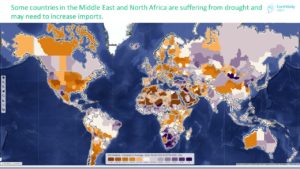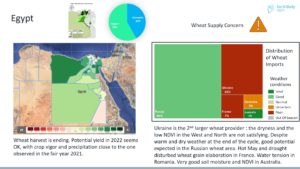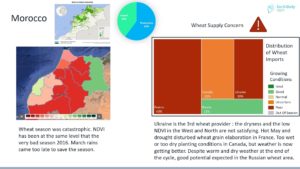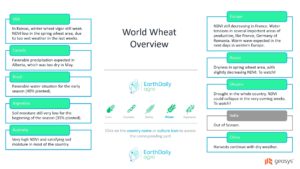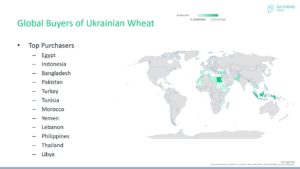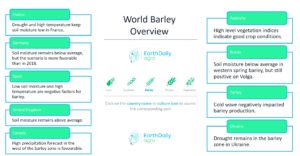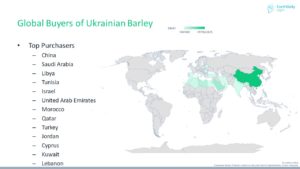
Water-Use Efficiency Is Key to Addressing North Africa’s Food Production Challenges
With countries around the world stepping up domestic agricultural production in an attempt to make up for decreased agricultural imports amidst the Russia-Ukraine war, nations need to make the most of their resources in order to maximize yields. In some countries, it will be especially important to optimize use of one resource in particular — water. Northern African countries such as Morocco are experiencing year-over-year decreases in moisture, EarthDaily Analytics Mosaic data shows. With less water to work with than in years past, it is now more important than ever for Moroccan and North African farmers to make the most of every drop.
Using high-precision satellite imagery, EarthDaily Agro can help these farmers optimize their water efficiency by pinpointing which field zones need moisture the most, helping farmers maximize their yields with the resources they have available. Ultimately, the use of Earth Observation in North Africa has the potential to help stabilize supplies (and thereby market prices) of the major crops produced by the region, such as wheat, barley, corn, rapeseed and more.
Drought situation in Morocco and across the Maghreb
In recent decades, Morocco and North African countries have made good progress to improve food production and reduce food security. Better management of chemicals and fertilizer, better developed supply chains, plus advances in machine technology have increased yields. But several factors now place the region known as the Maghreb in the crosshairs of renewed and alarming food security issues: the war in Ukraine and its supply chain disruptions, COVID-19 and a devasting drought that was the worst in 30 years. Produce outputs such as wheat decreased significantly, while water use throughout the region skyrocketed and depleted groundwater aquifers. As a result, food security and water scarcity are now inter-linked crises. Solving food security issues means addressing water scarcity issues.
The role of Earth Observation in solving food insecurity and water scarcity
Earth Observation plays a major role in the solution by giving agronomists, farmers, governments and NGOs the data and analytics they need to identify problems and make informed decisions. One way is to identify areas where water can be used most efficiently. Another way is to identify sources for importing needed crops to meet domestic demand. Both solutions help the food security issue.
Identifying areas of water availability
EarthDaily Agro’s satellite-based analytics platform <geosys/> helps farmers and others identify soil moisture, including current, average and forecast by field, country and across a region. The <geosys/> combination of powerful app, robust data stream and expert analytical services delivers the information needed to identify potential problems based on weather, climate and, in the case of water, natural resources.
Earth Daily Agro’s Mosaic delivers a clear picture of field conditions. The Mosaic is a high-resolution, true-color composite image of the Earth’s surface compiled from multiple satellite images over time. The benefit of a Mosaic is that it paints the full picture of a region over a specified period of time, as opposed to a single snapshot. This allows the image to be corrected for anomalies such as weather patterns, atmosphere (clouds, haze and smoke), sun angle (corrected for comparison across time and source), as well as masking (clouds and shadows that interfere with quality data are omitted). The Mosaic features normalized difference vegetation index and normalized difference water index It is also valuable for comparing seasonal trends year-over-year.
EarthDaily Agro’s Africa and Middle East Drought Monitoring Overview Report identifies conditions of wheat crops in different regions of the world and how supply may be affected. Countries whose own crops are affected by drought may have to increase their imports to meet domestic demand. Uncertainty about the supply of Ukrainian and Russian wheat may further reduce the supply. This makes it challenging for the Maghreb to meet domestic demand and minimize risk to food security.
Egypt anticipates disruption and buys wheat
Morocco, Tunisia and Egypt buy most of their wheat from Ukraine and Russia. The Russia-Ukraine war has disrupted supply. Egypt anticipated this disruption and bought 465,000 tonnes of wheat in May from as an international tender from Russia, Ukraine and Romania—at a cost-and-freight price of $480 per tonne, or 41% higher than pre-invasion prices. Egypt anticipates it will meet the remainder of its domestic need from its own production. The harvest is anticipated in July and geoanalytics indicate the yield will be sufficient.
In Morocco, the wheat season was catastrophic. NDVI has been at the same level as a poor season in 2017, and March rains came too late to save the crop. Ukraine supplies 20% of Morocco’s wheat, so other exporters may have to make up the difference. Canada got off to a slow start in planting, while France is also facing a dry year. Russian yields are promising, but the question is whether Russia can produce enough to meet demand.
Global Wheat Buyer Monitoring Report
Barley
Countries of the Maghreb are also major importers of barley. Meeting domestic need for this crop will also be a challenge due to similar circumstances for wheat: supply chain disruptions, local drought, and climate conditions in exporting countries.
Global Barley Buyer Monitoring Report
Food production, food insecurity and undernourishment are more of a threat than ever for citizens of the Maghreb. Drought and water-intensive farming have stressed the countries’ water supplies. Solving the food security crisis means solving water scarcity. Through satellite imagery and geoanalytics, governments and NGOs can identify how to apply precious resources—water—in specific zones. As a result, grower and government mitigate risk, help feed their populations and prevent massive population displacement from lack of food.
Crop-monitoring reports for wheat, corn and rapeseed
EarthDaily crop monitoring reports focus on a different crop and its health across major producing countries as well as potential impacts to dependent importing countries. The initial report for wheat was released March 31, and a follow-up alert released May 11. Subsequent reports have also been released for corn (April 15), barley (May 5), rapeseed (June 1) and sunflower (June 16). All these reports were updated in June, so you can have up-to-date information on the status of each of these crops.
About the initiative
EarthDaily Analytics and its EarthDaily Agro agriculture division are harnessing the power of Earth Observation technology to actively monitor crop health around the world. Through this monitoring, EarthDaily is able to detect early warning signs of production distress, equipping food security organizations to take proactive action.
Learn more about the initiative at www.earthdailyagro.com/ukraine. For more information, contact our analysts, who can provide daily crop monitoring, weather forecasting and production estimation of crop-producing regions worldwide.

